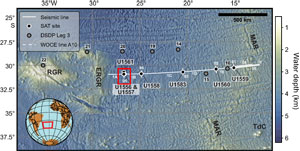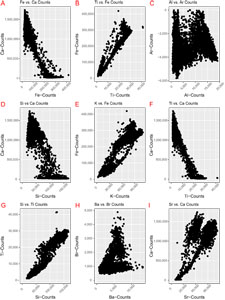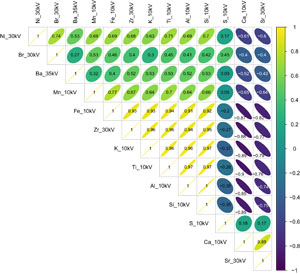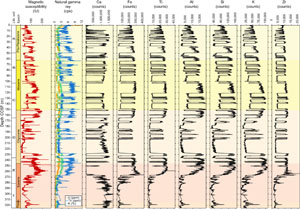Coggon, R.M., Teagle, D.A.H., Sylvan, J.B., Reece, J., Estes, E.R., Williams, T.J., Christeson, G.L., and the Expedition 390/393 Scientists
Proceedings of the International Ocean Discovery Program Volume 390/393
publications.iodp.org
https://doi.org/10.14379/iodp.proc.390393.206.2024
Data report: X-ray fluorescence scanning of sediment cores, IODP Expedition 390/393 Site U1556, South Atlantic Transect 1
Yi Wang,2 Chiara Amadori,2 Chiara Borrelli,2 Gail Christeson,2 Emily Estes,2 Laura Guertin,2 Jennifer Hertzberg,3 Michael R. Kaplan,2 Ravi Kiran Koorapati,4 Adriane R. Lam,2 Christopher M. Lowery,2 Andrew McIntyre,2 Julia Reece,2 Claudio Robustelli Test,2 Claire M. Routledge,2 Patricia Standring,5 Jason B. Sylvan,2 Mary Thompson,6 Alexandra Villa,2 Shu Ying Wee,2 Trevor Williams,2 Jesse Yeon,6 and the Expedition 390/393 Scientists2
1 Wang, Y., Amadori, C., Borrelli, C., Christeson, G., Estes, E., Guertin, L., Hertzberg, J., Kaplan, M.R., Koorapati, R.K., Lam, A.R., Lowery, C.M., McIntyre, A., Reece, J., Robustelli Test, C., Routledge, C.M., Standring, P., Sylvan, J.B., Thompson, M., Villa, A., Wee, S.Y., Williams, T., Yeon, J., and the Expedition 390/393 Scientists, 2024. Data report: X-ray fluorescence scanning of sediment cores, IODP Expedition 390/393 Site U1556, South Atlantic Transect. In Coggon, R.M., Teagle, D.A.H., Sylvan, J.B., Reece, J., Estes, E.R., Williams, T.J., Christeson, G.L., and the Expedition 390/393 Scientists, South Atlantic Transect. Proceedings of the International Ocean Discovery Program, 390/393: College Station, TX (International Ocean Discovery Program). https://doi.org/10.14379/iodp.proc.390393.206.2024
2 Expedition 390/393 Scientists' affiliations. Correspondence author: ywang145@tulane.edu
3 International Ocean Discovery Program, Texas A&M University, USA.
5 University of Texas at Austin, USA.
Abstract
International Ocean Discovery Program (IODP) Site U1556, located on a basement high above Site U1557, is one of the oldest sites drilled on the South Atlantic Transect with a basement age of ~61 Ma. Here, we present semiquantitative X-ray fluorescence core scan data from the Site U1556 splice and compare them with shipboard magnetic susceptibility and natural gamma ray (NGR) measurements to characterize elemental composition changes downcore. Elements primarily associated with detrital (e.g., Al, Fe, K, Ti, and Zr) and biogenic (e.g., Ca) sources are inversely correlated. Biogenic and detrital sourced elements vary synchronously with magnetic susceptibility and NGR measurements following alternations between silty clay and calcareous nannofossil ooze/chalk in Unit I, whereas biogenic sourced elements tend to dominate Unit II, corresponding to a lithology change to predominantly calcareous nannofossil ooze/chalk.
1. Introduction
The South Atlantic Transect (SAT; International Ocean Discovery Program [IODP] Expeditions 390C, 395E, 390, and 393) was drilled in 2020–2022 and is one of few coring efforts on oceanic crust in the western South Atlantic since Deep Sea Drilling Project (DSDP) Leg 3. The recovered sedimentary sequences provide a unique opportunity to investigate fundamental questions about oceanic responses (e.g., ocean circulation, productivity, and ocean chemistry) to major climate shifts (e.g., Eocene–Oligocene transition) over the last 61 My. The recovered sediments will contribute to understanding the evolving role of the South Atlantic in modulating global climate change.
Located in the western South Atlantic, Site U1556 (30°56.5244′S, 26°41.9472′W; 5002 m water depth) was drilled during Expeditions 390C and 390 (Figure F1; Coggon et al., 2024a). As one of the oldest sites drilled along the SAT, Site U1556 has the same basement age of ~61.2 Ma as Site U1561 (24 km north of Site U1556), which is slightly older than that of Site U1557 (6.7 km east of Site U1556; 60.7 Ma basement age). The sediment package from Site U1556 is about half as thick as Site U1557 because Site U1556 is sitting on a basement high and Site U1557 is sitting in the adjacent low (Coggon et al., 2024b).
Five holes were drilled at Site U1556 during Expeditions 390C and 390 (Holes U1556A–U1556E), and a splice was constructed from Holes U1556A, U1556C, U1556D, and U1556E. Holes U1556A (occupied during Expedition 390C) and U1556C (occupied during Expedition 390) were cored through the sediment/basement interface (~275 m of sediment), whereas Holes U1556D and U1556E only penetrated the uppermost portion of sediments (~10 and ~43 m, respectively). Sediments recovered from Site U1556 are a mixture of biogenic (predominantly calcareous nannofossil ooze/chalk) and siliciclastic (pelagic clay) sediments and are divided into two main lithologic units. Unit I (0 to ~281 m core composite depth below seafloor [CCSF]) comprises an alternation of predominantly nannofossil oozes/chalk and silty clays spanning the Pleistocene to early Eocene, whereas Unit II (~281–326 m CCSF) consists of calcareous nannofossil chalk or nannofossil-rich calcareous chalk of early Eocene to Paleocene age (Coggon et al., 2024b).
X-ray fluorescence (XRF) core scanning on Site U1556 sediments was carried out to generate semiquantitative and relatively high-resolution (mostly at 5 cm resolution) elemental composition data, especially elements used for paleoceanographic reconstructions (e.g., lithofacies and paleoproductivity), to identify first-order variability through time and facilitate future research in stratigraphy and high-resolution paleoceanographic reconstructions. In this report, we present quality-controlled XRF data against stratigraphy to reveal temporal variations of elemental compositions, as well as correlations among different elements. This report is also a part of XRF core scanning efforts of the SAT sites, including Sites U1557 (Lowery et al., 2024), U1558 (Villa et al., 2024), U1559 (Robustelli Test et al., 2024), U1560 (Amadori et al., 2024), U1561 (Routledge et al., 2024), and U1583 (Lam et al., 2024).
2. Methods and materials
In the fall of 2022, core sections from the Site U1556 splice (Coggon et al., 2024b) were scanned on the fourth generation Avaatech XRF Core Scanner (XRF 2) at the IODP Gulf Coast Core Repository in College Station, Texas (USA). The instrument is fitted with a water-cooled 100 W rhodium side-window X-ray tube, a Brightspec SiriusSD silicon drift detector, and a Topaz-X high-resolution digital multichannel analyzer. Some off-splice sections close to the splice tie points were also scanned for splice refinement. Each archive-half section was scanned at 3 voltages (10, 30, and 50 kV) to cover a large range of elements. The 10 kV scan was conducted without a filter, and with a tube current of 0.15 mA and a measurement (live) time of 6 s to detect Al, Si, P, S, Cl, Ar, K, Ca, Ti, Cr, Mn, and Fe. The 30 kV scan was conducted with a thick Pd filter, a tube current of 1.24 mA, and a measurement time of 6 s to target heavier major and minor elements, including Fe, Co, Ni, Cu, Zn, Ga, As, Br, Rb, Sr, Y, Zr, Nb, and Mo. The 50 kV scan was conducted with a Cu filter, a tube current of 0.75 mA, and a measurement time of 10 s to detect Ni, Rb, Sr, Ag, and Ba. The slit size (where the core surface is exposed to X-rays) was set at 10 mm (downcore direction) × 12 mm (cross-core direction). All scans were run down the center line of the split section half.
2.1. Core preparation
Refrigerated archive-half sections were allowed to equilibrate to room temperature prior to scanning. Glass slides were used to scrape the core surface in the cross-core direction to remove mold and ensure a smooth and fresh core surface. The slides were cleaned with water and lint-free wipes between each slide. A 4 µm thick Ultralene film was then placed over the core to prevent contamination of the XRF detector. This film was then taped along the edges, and air pockets were removed by gently pressing the film onto the core surface so the detector could land firmly on the core surface and data were not compromised by pockets of air.
2.2. Sample selection
The Site U1556 splice was scanned at 5 cm resolution except for a few intervals of special interest. Sections 390-U1556C-1H-5 and 1H-6 (5.61–6.44 m CCSF) were scanned at 1 and 2.5 cm resolution, respectively, to capture the diatom-rich (high biogenic silica) interval (Coggon et al. , 2024b). Other suspected diatom-rich intervals in Sections 390C-U1556A-1H-3 and 5H-1 were also scanned at 2 cm resolution. Additionally, Cores 390-U1556C-22X through 26X (207.83–263.20 m CCSF) were scanned at 2 cm increments to better characterize the Eocene–Oligocene transition. The first scan point in each section was usually selected 5 cm below the top of the section, and the last point was placed as close to the bottom of the section as possible. Whenever the anticipated scanning point had a crack, uneven surface, and/or was affected by drilling disturbance, this sample point was skipped and/or moved to the best alternative nearby. Such examination ensures that the data are not compromised by air pockets between the core surface and the X-ray detector. For extended core barrel (XCB) cores that were more affected by drilling disturbance (e.g., biscuiting; Pearson and Thomas, 2015), care was taken to specifically select sample points on the firm biscuits, whereas soft intervals due to drilling disturbance were skipped, leading to some data gaps in the otherwise high-resolution data set. All scanned Site U1556 sections with the scanning resolution are summarized in TableS1.xlsx in XRF in Supplementary material.
2.3. Quality control
To ensure data consistency during scanning, standards (SARM 2 [syenite], SARM 4 [norite], and SARM 45 [kinzigite]) were run at all three voltages (10, 30, and 50 kV) at the beginning and end of each day. A total of 20 replicates were run in the morning to warm up the machine; no replicates were run for the standards at the end of the day. XRF spectra were processed to obtain peak areas and elemental raw counts using bAxil by Avaatech. Raw counts were screened based on two criteria. Measurements with total counts <150,000 counts/s during the 10 kV scan or with positive Ar values were removed because those data could have been compromised by air presence during the measurements (e.g., because of sample cracks, uneven surface, and pockets of air). Negative elemental counts were treated as below the detection limit. Data quality control was performed using R (https://github.com/Ravikiran2316/IODP-Exp.-390-393-XRF).
3. Results
3.1. Correlation between elements
The effectiveness of quality control was evaluated using a crossplot of Al and Ar (Figure F2C). Al counts are significantly attenuated with air presence (suggested by less negative Ar counts) during measurements, and thus the air impact would lead to a negative correlation between Ar and Al counts. The lack of correlation between Al and Ar suggests that the quality controlled data set is overall robust. However, we caution that this quality control does not necessarily exclude all low-quality data, and interpretation of these data points requires further scrutiny. For instance, some elements have low counts that are close to the detection limits, which may be attributed to peak interferences and/or various water content in the core (Tjallingii et al., 2007). To quantify correlations among different elements, Spearman’s rank correlation was performed (Figure F3), which is a nonparametric measure of how well the relationship between two variables can be described using a monotonic function. Unlike Pearson correlation, Spearman’s correlation does not assume normal distribution of the data set and does not require linear relationships. Because of the lack of normal distribution in the elemental raw counts, Spearman’s rank correlation coefficient (ρ) was used to evaluate the monotonic relationships between elements (Figure F3). Selected crossplots of elements dominated by detrital/productivity sources that show statistically significant Spearman’s correlations are shown in Figure F2. Positive correlations (ρ > 0) are observed between elements primarily associated with detrital input (Croudace and Rothwell, 2015), including Al, Fe, K, Si, Ti, and Zr, whereas detrital elements show negative correlations (ρ < 0) with elements dominated by productivity (e.g., Ca and Sr) (Figures F2, F3). We note that the Ba and Br scatter plot (Figure F2H) shows a distribution with two clusters, which suggests that multiple factors could have affected their XRF counts. Ni, Br, Ba, and Mn all have positive ρ values with detrital elements and negative correlations with biogenic elements (Ca and Sr). However, Br and Ba have weaker correlations compared to Ni and Mn. S is only weakly correlated with biogenic elements (Ca and Sr), Ni, Ba, and Mn but has a positive correlation with Br (ρ = 0.45) and negative correlations with detrital elements (Al, Fe, K, Si, Ti, and Zr), albeit with relatively weak correlations (ρ of −0.2 to −0.37).
3.2. Stratigraphic trends
Selected biogenic and lithogenic elements are plotted with magnetic susceptibility, three components (U, Th, and K) of natural gamma ray (NGR), and sedimentary units to compare stratigraphic trends of XRF scan data with shipboard measurements (Figure F4). Because Site U1556 sediments alternate between calcareous nannofossil (predominantly) ooze/chalk and silty clay, elements dominated by detrital (Fe, Ti, Al, Si, K, and Zr) and biogenic sources (Ca) all show synchronous changes with magnetic susceptibility and NGR. Clay-rich intervals are characterized by high magnetic susceptibility; high U, Th, and K from NGR; high counts of detrital elements; and low Ca. The carbonate-rich nannofossil ooze/chalk intervals are dominated by high Ca counts, coeval with much lower magnetic susceptibility and NGR-derived U, Th, and K.
A downcore increase in magnetic susceptibility and NGR in the silty clay intervals of Subunits IA–IC corresponds to a similar increase in XRF counts of detrital elements, most prominently in Al and K. All detrital elemental counts decrease in Subunit ID. The upper portion of Subunit IE (~235–265 m CCSF) has the highest magnetic susceptibility and NGR values, which is consistent with the highest counts of detrital elements (Fe, Ti, Al, Si, K, and Zr). On the other hand, Ca counts decrease slightly in the calcareous ooze intervals from Subunits IA and IB but remain stable in Subunits IB and IC and increase slightly to a local maxima in Subunit ID. The lower portion of Subunit IE (below ~265 m CCSF) and Unit II have the lowest magnetic susceptibility and NGR counts, which is coincident with the highest Ca counts and the lowest detrital element counts throughout the record.
4. Data availability
XRF data at all three excitation levels are included here as supplementary tables (see TableS2.xlsx, TableS3.xlsx, and TableS4.xlsx in XRF in Supplementary material) and will be permanently archived at PANGAEA (https://Pangea.de).
5. Acknowledgments
XRF scans reported here comprised the programmatic scanning for IODP Expeditions 390 and 393 and were funded by National Science Foundation (NSF) in agreement with the US Science Support Program (USSSP). We also acknowledge XRF scanning travel support for US scientists administered by USSSP and support of E.R. Estes and T.J. Williams through NSF Award OCE-1326927. We are grateful for the technicians and crew of the R/V JOIDES Resolution, without whom we would not have any cores to scan. We are also grateful to the staff of the Gulf Coast Repository, especially Michelle Penkrot. We thank the reviewer for constructive feedback that strengthened presentation of this data set.
References
Amadori, C., Borrelli, C., Christeson, G., Estes, E., Guertin, L., Hertzberg, J., Kaplan, M.R., Koorapati, R.K., Lam, A.R., Lowery, C.M., McIntyre, A., Reece, J., Robustelli Test, C., Routledge, C.M., Standring, P., Sylvan, J.B., Thompson, M., Villa, A., Wang, Y., Wee, S.Y., Williams, T., Yeon, J., Teagle, D.A.H., Coggon, R.M., and the Expedition 390/393 Scientists, 2024. Data report: X-ray fluorescence scanning of sediment cores, IODP Expedition 390/393 Site U1560, South Atlantic Transect. In Coggon, R.M., Teagle, D.A.H., Sylvan, J.B., Reece, J., Estes, E.R., Williams, T.J., Christeson, G.L., and the Expedition 390/393 Scientists, South Atlantic Transect. Proceedings of the International Ocean Discovery Program, 390/393: College Station, TX (International Ocean Discovery Program). https://doi.org/10.14379/iodp.proc.390393.205.2024
Coggon, R.M., Teagle, D.A.H., Sylvan, J.B., Reece, J., Estes, E.R., Williams, T.J., Christeson, G.L., Aizawa, M., Albers, E., Amadori, C., Belgrano, T.M., Borrelli, C., Bridges, J.D., Carter, E.J., D’Angelo, T., Dinarès-Turell, J., Doi, N., Estep, J.D., Evans, A., Gilhooly, W.P., III, Grant, L.C.J., Guérin, G.M., Harris, M., Hojnacki, V.M., Hong, G., Jin, X., Jonnalagadda, M., Kaplan, M.R., Kempton, P.D., Kuwano, D., Labonte, J.M., Lam, A.R., Latas, M., Lowery, C.M., Lu, W., McIntyre, A., Moal-Darrigade, P., Pekar, S.F., Robustelli Test, C., Routledge, C.M., Ryan, J.G., Santiago Ramos, D., Shchepetkina, A., Slagle, A.L., Takada, M., Tamborrino, L., Villa, A., Wang, Y., Wee, S.Y., Widlansky, S.J., Yang, K., Kurz, W., Prakasam, M., Tian, L., Yu, T., and Zhang, G., 2024a. Expedition 390/393 summary. In Coggon, R.M., Teagle, D.A.H., Sylvan, J.B., Reece, J., Estes, E.R., Williams, T.J., Christeson, G.L., and the Expedition 390/393 Scientists, South Atlantic Transect. Proceedings of the International Ocean Discovery Program, 390/393: College Station, TX (International Ocean Discovery Program). https://doi.org/10.14379/iodp.proc.390393.101.2024
Coggon, R.M., Sylvan, J.B., Estes, E.R., Teagle, D.A.H., Reece, J., Williams, T.J., Christeson, G.L., Aizawa, M., Borrelli, C., Bridges, J.D., Carter, E.J., Dinarès-Turell, J., Estep, J.D., Gilhooly, W.P., III, Grant, L.C.J., Kaplan, M.R., Kempton, P.D., Lowery, C.M., McIntyre, A., Routledge, C.M., Slagle, A.L., Takada, M., Tamborrino, L., Wang, Y., Yang, K., Albers, E., Amadori, C., Belgrano, T.M., D’Angelo, T., Doi, N., Evans, A., Guérin, G.M., Harris, M., Hojnacki, V.M., Hong, G., Jin, X., Jonnalagadda, M., Kuwano, D., Labonte, J.M., Lam, A.R., Latas, M., Lu, W., Moal-Darrigade, P., Pekar, S.F., Robustelli Test, C., Ryan, J.G., Santiago Ramos, D., Shchepetkina, A., Villa, A., Wee, S.Y., Widlansky, S.J., Kurz, W., Prakasam, M., Tian, L., Yu, T., and Zhang, G., 2024b. Site U1556. In Coggon, R.M., Teagle, D.A.H., Sylvan, J.B., Reece, J., Estes, E.R., Williams, T.J., Christeson, G.L., and the Expedition 390/393 Scientists, South Atlantic Transect. Proceedings of the International Ocean Discovery Program, 390/393: College Station, TX (International Ocean Discovery Program). https://doi.org/10.14379/iodp.proc.390393.103.2024
Croudace, I.W., and Rothwell, R.G. (Eds.), 2015. Micro-XRF Studies of Sediment Cores: Applications of a non-destructive tool for the environmental sciences: (Springer Dordrecht). https://doi.org/10.1007/978-94-017-9849-5
Lam, A.R., Amadori, C., Borrelli, C., Christeson, G., Estes, E., Guertin, L., Hertzberg, J., Kaplan, M.R., Koorapati, R.K., Lowery, C.M., McIntyre, A., Reece, J.S., Robustelli Test, C., Routledge, C.M., Standring, P., Sylvan, J.B., Thompson, M., Villa, A., Wang, Y., Wee, S.Y., Williams, T., Yeon, J., Teagle, D.A.H., Coggon, R.M., and the Expedition 390/393 Scientists, 2024. Data report: X-ray fluorescence scanning of sediment cores, IODP Expedition 390/393 Site U1583, South Atlantic Transect. In Coggon, R.M., Teagle, D.A.H., Sylvan, J.B., Reece, J., Estes, E.R., Williams, T.J., Christeson, G.L., and the Expedition 390/393 Scientists, South Atlantic Transect. Proceedings of the International Ocean Discovery Program, 390/393: College Station, TX (International Ocean Discovery Program). https://doi.org/10.14379/iodp.proc.390393.202.2024
Lowery, C.M., Amadori, C., Borrelli, C., Christeson, G., Estes, E., Guertin, L., Hertzberg, J., Kaplan, M.R., Koorapati, R.K., Lam, A.R., McIntyre, A., Reece, J., Robustelli Test, C., Routledge, C.M., Standring, P., Sylvan, J.B., Thompson, M., Villa, A., Wang, Y., Wee, S.Y., Williams, T., Yeon, J., Teagle, D.A.H., Coggon, R.M., and the Expedition 390/393 Scientists, 2024. Data report: X-ray fluorescence scanning of sediment cores, IODP Expedition 390/393 Site U1557, South Atlantic Transect. In Coggon, R.M., Teagle, D.A.H., Sylvan, J.B., Reece, J., Estes, E.R., Williams, T.J., Christeson, G.L., and the Expedition 390/393 Scientists, South Atlantic Transect. Proceedings of the International Ocean Discovery Program, 390/393: College Station, TX (International Ocean Discovery Program). https://doi.org/10.14379/iodp.proc.390393.201.2024
Pearson, P.N., and Thomas, E., 2015. Drilling disturbance and constraints on the onset of the Paleocene–Eocene boundary carbon isotope excursion in New Jersey. Climate of the Past, 11(1):95–104. https://doi.org/10.5194/cp-11-95-2015
Robustelli Test, C., Amadori, C., Borrelli, C., Christeson, G., Estes, E., Guertin, L., Hertzberg, J., Kaplan, M.R., Koorapati, R.K., Lam, A.R., Lowery, C.M., McIntyre, A., Reece, J., Routledge, C.M., Standring, P., Sylvan, J.B., Thompson, M., Villa, A., Wang, Y., Wee, S.Y., Williams, T., Yeon, J., Teagle, D.A.H., Coggon, R.M., and the Expedition 390/393 Scientists, 2024. Data report: X-ray fluorescence scanning of sediment cores, IODP Expedition 390/393 Site U1559, South Atlantic Transect. In Coggon, R.M., Teagle, D.A.H., Sylvan, J.B., Reece, J., Estes, E.R., Williams, T.J., Christeson, G.L., and the Expedition 390/393 Scientists, South Atlantic Transect. Proceedings of the International Ocean Discovery Program, 390/393: College Station, TX (International Ocean Discovery Program). https://doi.org/10.14379/iodp.proc.390393.204.2024
Routledge, C.M., Amadori, C., Borrelli, C., Christeson, G., Estes, E., Guertin, L., Hertzberg, J., Kaplan, M.R., Koorapati, R.K., Lam, A.R., Lowery, C.M., McIntyre, A., Reece, J., Robustelli Test, C., Standring, P., Sylvan, J.B., Thompson, M., Villa, A., Wang, Y., Wee, S.Y., Williams, T., Yeon, J., Teagle, D.A.H., Coggon, R.M., and the Expedition 390/393 Scientists, 2024. Data report: X-ray fluorescence scanning of sediment cores, IODP Expedition 390/393 Site U1561, South Atlantic Transect. In Coggon, R.M., Teagle, D.A.H., Sylvan, J.B., Reece, J., Estes, E.R., Williams, T.J., Christeson, G.L., and the Expedition 390/393 Scientists, South Atlantic Transect. Proceedings of the International Ocean Discovery Program, 390/393: College Station, TX (International Ocean Discovery Program). https://doi.org/10.14379/iodp.proc.390393.207.2024
Teagle, D.A.H., Reece, J., Coggon, R.M., Sylvan, J.B., Christeson, G.L., Williams, T.J., Estes, E.R., and the Expedition 393 Scientists, 2023. Expedition 393 Preliminary Report: South Atlantic Transect 2. International Ocean Discovery Program. https://doi.org/10.14379/iodp.pr.393.2023
Tjallingii, R., Röhl, U., Kölling, M., and Bickert, T., 2007. Influence of the water content on X-ray fluorescence core-scanning measurements in soft marine sediments. Geochemistry, Geophysics, Geosystems, 8(2):Q02004. https://doi.org/10.1029/2006GC001393
Villa, A., Amadori, C., Borrelli, C., Christeson, G., Estes, E., Guertin, L., Hertzberg, J., Kaplan, M.R., Koorapati, R.K., Lam, A.R., Lowery, C.M., McIntyre, A., Reece, J., Robustelli Test, C., Routledge, C.M., Standring, P., Sylvan, J.B., Thompson, M., Wang, Y., Wee, S.Y., Williams, T., Yeon, J., Teagle, D.A.H., Coggon, R.M., and the Expedition 390/393 Scientists, 2024. Data report: X-ray fluorescence scanning of sediment cores, IODP Expedition 390/393 Site U1558, South Atlantic Transect. In Coggon, R.M., Teagle, D.A.H., Sylvan, J.B., Reece, J., Estes, E.R., Williams, T.J., Christeson, G.L., and the Expedition 390/393 Scientists, South Atlantic Transect. Proceedings of the International Ocean Discovery Program, 390/393: College Station, TX (International Ocean Discovery Program). https://doi.org/10.14379/iodp.proc.390393.203.2024
Wang, Y., Amadori, C., Borrelli, C., Christeson, G., Estes, E., Guertin, L., Hertzberg, J., Kaplan, M.R., Koorapati, R.K., Lam, A.R., Lowery, C.M., McIntyre, A., Reece, J., Robustelli Test, C., Routledge, C.M., Standring, P., Sylvan, J.B., Thompson, M., Villa, A., Wee, S.Y., Williams, T., Yeon, J., and the Expedition 390/393 Scientists, 2024. Supplementary material, https://doi.org/10.14379/iodp.proc.390393.206supp.2024. In Wang, Y., Amadori, C., Borrelli, C., Christeson, G., Estes, E., Guertin, L., Hertzberg, J., Kaplan, M.R., Koorapati, R.K., Lam, A.R., Lowery, C.M., McIntyre, A., Reece, J., Robustelli Test, C., Routledge, C.M., Standring, P., Sylvan, J.B., Thompson, M., Villa, A., Wee, S.Y., Williams, T., Yeon, J., and the Expedition 390/393 Scientists, Data report: X-ray fluorescence scanning of sediment cores, IODP Expedition 390/393 Site U1556, South Atlantic Transect. In Coggon, R.M., Teagle, D.A.H., Sylvan, J.B., Reece, J., Estes, E.R., Williams, T.J., Christeson, G.L., and the Expedition 390/393 Scientists, South Atlantic Transect. Proceedings of the International Ocean Discovery Program, 390/393: College Station, TX (International Ocean Discovery Program).



